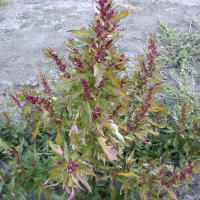Red goosefoot
Chenopodium rubrum
Chenopodium rubrum, commonly known as red goosefoot or red lambsquarters, is a herbaceous plant belonging to the amaranth family, Amaranthaceae. It is part of the larger genus Chenopodium, which includes several species commonly known as goosefoots or lambsquarters. Here's an informative description of Chenopodium rubrum:
Appearance:
-
Habit:
- Red goosefoot is an annual or short-lived perennial plant.
-
Leaves:
- The leaves are typically triangular to diamond-shaped, with toothed or lobed margins.
- The foliage may have a reddish tint, especially in younger leaves, contributing to the common name.
-
Stems:
- The stems are often reddish or purplish, providing another characteristic feature.
-
Flowers:
- Inconspicuous greenish flowers are borne in clusters.
Identification:
-
Leaf Shape:
- The distinctive triangular to diamond-shaped leaves are a key identifier.
-
Reddish Stems:
- The reddish or purplish tint of the stems is a characteristic feature.
Habitat and Distribution:
-
Habitat:
- Red goosefoot is commonly found in disturbed areas, gardens, agricultural fields, and waste places.
-
Distribution:
- It has a broad distribution and can be found in various regions around the world.
Ecological and Cultural Significance:
-
Edible Uses:
- Like other members of the Chenopodium genus, red goosefoot is edible, and young leaves can be used in salads or cooked as a leafy vegetable. However, caution is advised, as some species may contain oxalates and should be consumed in moderation.
-
Weed or Cultivated Crop:
- Depending on the context, red goosefoot may be considered a weed in agricultural settings or intentionally cultivated as a food source.
Management:
-
Cultural Practices:
- In agricultural settings, regular cultivation and weeding may be employed to manage red goosefoot.
-
Harvesting:
- If intentionally cultivated, red goosefoot can be harvested for its edible leaves.
-
Mulching:
- Applying mulch can help suppress the growth of unwanted plants in garden settings.
-
Herbicides:
- Selective herbicides may be used for weed control in agricultural or landscaped areas.









